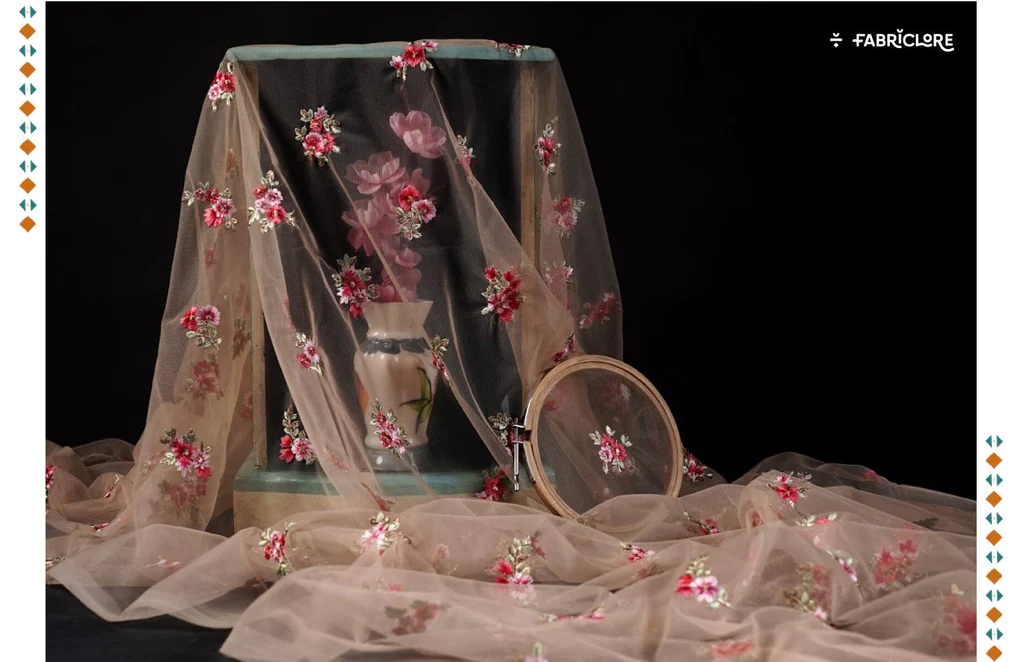The term “net fabrics” is used to describe all types of open mesh textiles. Net fabric, with its numerous holes, is created by knitting, knotting, looping, or twisting yarns at their intersections. The shapes of these openings vary widely ( maybe four-sided, six-sided, or more). However, you may get a square, a hexagon, or an octagon.
Nowadays, knitted fabrics are the norm for nets. The shape of the holes is determined by the construction method used to make the net fabric, which may be one of three types: Tricot, Raschel, or Bobbinet. The majority of nets are made using a knitting method called Rachel. The holes in this netting have a mathematical structure, and they’re knitted using knitting yarns. Moreover, pillow and tricot stitching work together to make the cloth.
Fabrics including silk, polyester, rayon, dacron, acetate, and nylon may all be used to create nets. To a large extent, the fabric’s feel is determined by its makeup. Also, it may range from soft to rough to rigid. Nylon netting is rather hard whereas silk netting is extremely soft. The fineness of polyester netting may vary greatly. Most fabric shops have nylon nets, which is the most popular kind of net.
Basically, dressmaking is simplified by using net fabric. The list of clothing that may benefit from the use of net fabric is extensive and includes lingerie, gowns, hosiery, bodysuits, and body stockings. Veils, underskirts, interlining, and evening gown overlays are commonplace uses for the net. It is used to create decorative embellishments like frills and ruffles.
Millinery would benefit greatly from this material. Veils for hats often come in the form of a gauzy, net-like fabric. Net fabric with medium holes is ideal for skirt overlays. For bridal veils, a net fabric with tiny holes works well.
Fabrics of many types are made from nets
Tulle
The most well-known kind of netting, tulle, is a very fine net fabric created using the tricot fabrication process. The tiny holes have a hexagonal shape. Finer strands and smaller hole sizes combine to make airy fabrics known as tulle and illusion. Tulle is unique among netting materials in that its low denier makes it both delicate and supple.
The best tulle is crafted from silk fibers. Overskirts, ruffles, embellishments, and evening dresses are all perfect candidates for this fabric. Illusion net is used to make bridal veils. Learn more about Tulle, and related topics, here.
Bobbinet
This net fabric has both English and French names. The net was created by John Heathcoat of Nottingham, England in 1808. Bobbinet is often a very fine net fabric made in the style of lace, albeit it is considerably thicker when made from cotton yarn. The holes are readily distinguishable because of their distinctive hexagonal shape. It’s a really durable fabric, despite the fact that it’s rather delicate. Purchasing high-quality bobbinet fabric won’t come cheap.
Fishnet
The netting here is rather thick. It’s made by tying yarn in a knot as a fisherman would use it. It has polyester or nylon yarn with a tiny bit of elastane fibers added for stretchiness. Hosiery, bodysuits, body stockings, and also other clothing items are made from it.
Maline
Diamond-shaped holes punched in a maline net. Also, there is a high degree of quality to the cloth.
French Net
This net features large, six-sided (diamond-shaped) openings and is of low quality. The sheer, open mesh fabric is often used to create birdcage veils.
Russian netting
Comparable to the French net, but with larger openings. It’s comparable to the Merry Widow netting used in England.
Crinoline
This is a nylon or polyester filament net used to make full-skirted underskirts (petticoats) used under more fitted garments. Moreover, they are often constructed with many gathers and in tiers to give the impression of fullness.
Point d’esprit
Dotted or flock-printed onto the surface, this fabric is a kind of netting. It’s used to make veils for hats and other millinery creations.
Fence Net
Hosiery (stockings) are often made from this net fabric, which has elasticized with spandex. The holes tend to be rather large.
Industrial Net
The holes in the industrial Net fabric are larger than those in conventional fishnets but smaller than those in fence nets. The strands are thick.
Making and designing nets for fabrics
It’s possible to create any pattern or design you want using net fabric. By sewing in netting in strategic places, the silhouette may easily be altered.
Netting cloth does not have fraying edges. Although this does not make cutting and stitching any easier. The question, “What do you sew?” – has more holes than the surface! – is a severe concern when stitching net fabric.
It is simpler to sew the seams together with a solid piece of fabric before adding the net. Due to its transparency, more care must be used while cutting and finishing seams. Even from the exterior, a bound finish looks neat and tidy.
However, a thin fabric like chiffon is used to bind the seam allowance of the net.
Beading and other needlework done on the net fabric must take into consideration the fact that it is completely see-through.
Finding the pattern online is another challenge. The pattern on the fabric should be kept intact during cutting. Tailor’s tack stitches are used to denote details like darts.
Tulle is very fragile and quickly tears, so please handle it with care. If you use the net as a background for delicate embroidery, you need to use stabilizers to ensure it stays there. Ironing the yarn requires care to prevent scorching.
If you are looking for fabrics in Middle East then don’t look further, because Fabriclore is here! We have a collection of certified fabrics including net fabrics which you can find in bulk.


